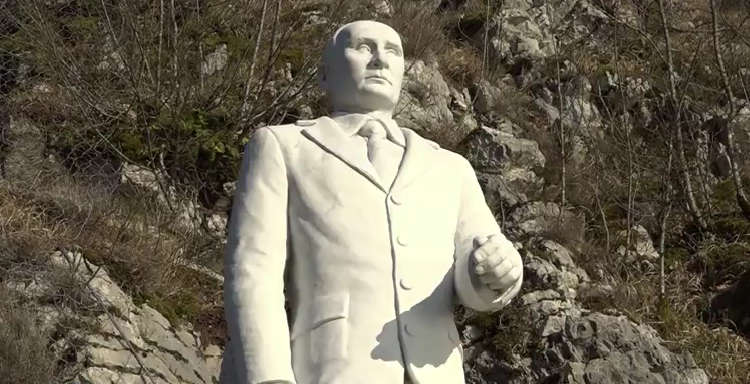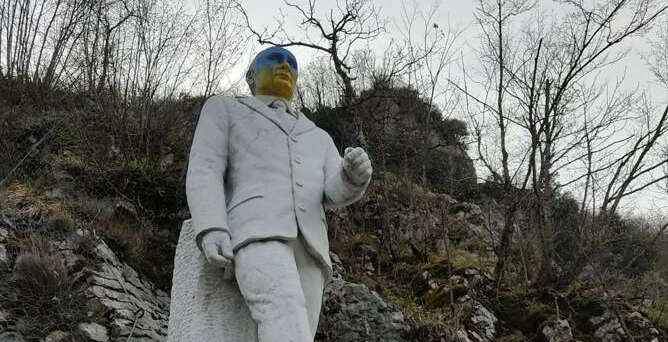What are these monuments for? In the park in Garfagnana where there is (still!) the statue of Putin
“Walk between honor and dishonor!” invites the website of Vagli Park, in the municipality of Vagli di Sotto, in the province of Lucca: inside the park there are, in addition to some trekking paths, an adventure trail, a zipline, a suspension bridge, but above all the so-called "Park of honor and dishonor." This is a path along which some 20 local marble sculptures depicting topical figures can be found. Conceived by former Vagli Mayor Mario Puglia, the park was launched in 2015 with the unveiling of sculptures dedicated to Commander Francesco Schettino and Captain Gregorio De Falco: on honor and dishonor, their example is clear, especially since De Falco’s plinth is engraved with the famous phrase (“go on board, fuck,” although erroneously reported on the statue as “go back on board, fuck”) and that Schettino, very recognizable but identified by the inscription as “Francesco” (then again, he is unlikely to have given consent for this sculpture) is portrayed with rabbit ears. These two progenitors are soon joined by other sculptures, and the categories of honor and dishonor become decidedly more fluid: there is Trump, Putin, the police dog Diesel (who was killed in a shooting in France), the security guard Fabrizio Quattrocchi, an anti-femicide statue featuring a pregnant woman and a reclining one, a bench that reads “women’s freedom is everyone’s freedom”, a sculpture dedicated to the Air Force Vigilance, one to the ADRA Battalion... “In a democracy, one must emphasize all expressions,” Mario Puglia said recently, while he had also previously emphasized, with a kind of tongue-twister, what he sees as the value of the park: “the statues will be an example and a warning to young people about the value of honor and the disvalue of dishonor.”
However, the outbreak of war in Ukraine soon tested the validity of this value system. After the Feb. 24, 2022, Enzo Coltelli (secretary of the local PD) called, also on behalf of many outraged citizens, for the removal of the Kremlin leader’s statue, stating precisely that “the honor of our country and of all the citizens of Vagli depends on it.” To which Puglia, putting aside the categories of honor and dishonor, responded by saying that Putin’s statue would bring tourism to the country and moreover would be worth 150,000 euros. The work, Puglia told Corriere Fiorentino again, “like all statues was donated for the enhancement of the marble and publicity to the material.” And indeed for the park, on public land, the municipality would not have spent a euro, “thanks to the enthusiastic participation of private individuals,” that is, local marble industries, which through the statues would advertise their materials. Even this aspect, however, remains unclear: a 2017 determination (the 222 dated Dec. 5) of the Vagli Municipality in fact shows the allocation of 10. 999 euros plus VAT as compensation to the author of the statue (the figure included, the determination reads, “the creation and supply of marble statue depicting the President of the Russian Federation”), and the “donors” themselves have so far remained incongruously anonymous, in the sense that, as far as we know, the names of the companies involved in the creation of the work have not been disclosed.
In fact, the citizenry has shown unwillingness to accept the statue, which has been daubed several times: in April 2022 the Kremlin leader was covered in red paint; in March this year his face was painted yellow and blue. “It’s an outrage,” commented Puglia, who persists in not wanting to question Putin’s presence in the park, incidentally in agreement with the current mayor, who, after Puglia’s justifications in economic and tourism terms, also tried the morality card again, proposing to keep Putin as an example of dishonor.


Too bad, however, that a “dishonorable” statue is a contradiction in terms. Then again, the whole moralistic set-up of the park is, besides being ridiculous, evidently specious: leaving aside Putin and Trump, what do honor and dishonor have to do with feminicide, told moreover in the most stereotypical way possible? Is the dog Diesel there because Puglia is anti-speciesist or to pay homage to dogs’ well-known sense of honor? And would the presence of the bench with the inscription be honorable or dishonorable? By the way, it is also worth mentioning the new arrivals, recently announced for 2024: Berlusconi, Don Milani, and Piero Angela, all together for 300,000 euros (inevitable comparison with Putin, who alone costs half as much as the whole trio). And that’s not all: Puglia also declared that “an explicit request for consent will be made for a statue of Travaglio, Scanzi and Santoro,” to also pay homage to the journalists who have been a thorn in Berlusconi’s side, but “perhaps with much smaller statues.”
In general, the discretion with which the former mayor was able to create his own very small and ambiguous world of values is striking. In this sense, that of honor and dishonor clearly seems to be a ploy to nurture a pseudo-democratic ambiguity around the presence of figures who actually reflect a political vision. What then is the meaning of these works? Is the park to be interpreted as merely an advertising enterprise? Or is it a tourism enterprise? If we compare it to other works in the Italian landscape, it is quite easy to frame it according to recurring phenomena, the most macroscopic of which is the appropriation of public space by private parties. In fact, as we have shown with aninvestigation and a recently published book,(However Naked. Female representation in Italian public monuments, Mimesis 2023), of the 187 statues on public land inaugurated in the last year, as many as 122 are donations from private individuals. Private individuals whose major purpose is to gain publicity for themselves, with the endorsement of public administrations, which typically justify these operations with the rhetoric of “redevelopment” and tourist development of the territory. One of the earliest examples of this is the statue dedicated to Manuela Arcuri, placed in 2002 in Porto Cesareo, never accepted by the citizenry (coincidentally, as in Vagli), removed in 2010 and relocated after 2 years with 6 suspects. Codacons had also taken an interest in the issue, arguing that the removal had damaged tourism. The more recent Spigolatrice in Sapri actually follows the same rhetoric: the foundation that financed the execution of the work presented it as a tourist attraction. The statue has indeed been trending on social media, where many photos of visitors immortalized touching her butt are circulating (the same practice has been ritualized with Arcuri’s statue as well: apparently it’s good luck), but whether tourists come to Sapri, or Porto Cesareo, on purpose remains to be proven. In the case of Vagli Park, the publicity intent, which, by the way, concerns a highly environmentally and landscape problematic industry, is openly stated, but it is not enough to explain the whole operation: the market for honor and dishonor makes possible a very peculiar ideological operation.
In fact, while it is clear that Vagli’s statues are fetishes on par with the one to Manuela Arcuri and the Spigolatrice, and that the park’s moralizing implantation is actually empty, it can be seen that the choice of subjects to be represented is neither random nor neutral. “My administration has in 20 years made Vagli a tourist pearl,” said Puglia, in defense of Putin’s statue. But what kind of tourism is the park of honor and dishonor aiming for? It seems unlikely that Vagli Park has really become a destination for right-wing tourism thanks to these statues, especially since, as was pointed out at the beginning, it is located in an area of great naturalistic and sporting interest, where the zipline, adventure park and Tibetan bridge (consistently named after the Marò) are the main attractions for visitors. A destination therefore suitable for family outings or with friends, which really would not have needed statues that seem to be randomly placed on the rocks. Statues that, by the way, do not even have the “virtue” of being Instagrammable: Putin, one of the few easily accessible, is on a very high pedestal and certainly does not lend himself to selfies like, say, the Lucio Dalla of Bologna, Troina or Milo, who are sitting on the bench, well disposed to have their picture taken with fans sitting next to them. Moreover, the reviews of Vagli Park on TripAdvisor mentioning the statues are very critical.
The “Park of Honor and Dishonor” is not really either a showcase for marble businesses or a credible tourist destination; rather, it appears as an ambitious project carried out without awareness and without a clear purpose, except to affirm in space the questionable values of its promoter, who then, in the face of the citizenry pointing out the ’problematic aspect of certain of his statues, seems to gloss over the full assumption of responsibility vagueing instead of tourism and publicity to entrepreneurs. Twenty authorless statues that would be cringe, as they say, in a private space and are, regardless of who paid for them, extremely questionable in public space.
Warning: the translation into English of the original Italian article was created using automatic tools. We undertake to review all articles, but we do not guarantee the total absence of inaccuracies in the translation due to the program. You can find the original by clicking on the ITA button. If you find any mistake,please contact us.




























